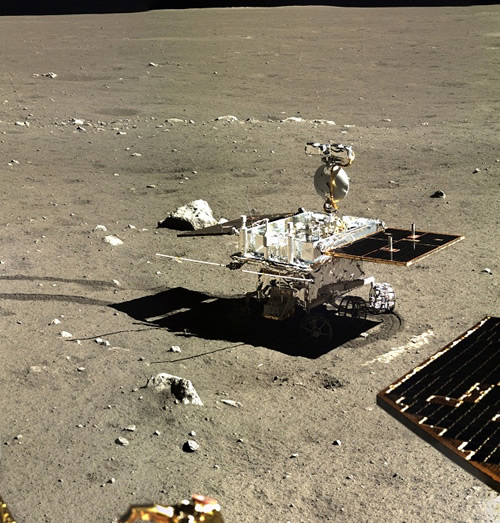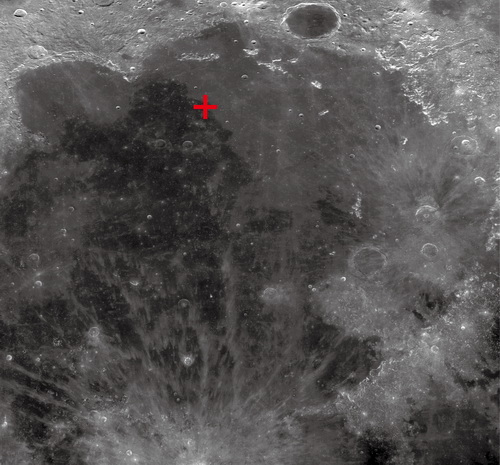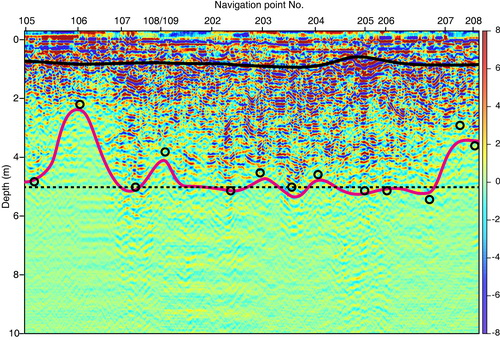The moon is the only satellite of Earth, which is the outpost and transfer station for the human’s further space exploration. On December 14, 2013, Chang’e-3 successfully landed on the young and high-Ti lava flow in the northeastern Mare Imbrium (Fig. 1). The Yutu Rover started its in situ experiments with several scientific payloads. China is the third country in the world to have independently performed a soft landing on the Moon.
In addition to a stereo camera, the Yutu Rover was equipped with three other scientific payloads: Lunar Penetrating Radar (LPR), Visible and Near-Infrared Imaging Spectrometer (VNIS) and Active Particle-Induced X-ray Spectrometer (APXS). During the first two months, Yutu performed two experiments on the lunar regolith using APXS and four experiments using VNIS, and obtained a nearly 100 meters long cross section using LPR (Fig. 2).
In order to “achieve much more solid scientific research results as soon as possible”, the General Office of the Lunar and Deep-space Exploration, CAS, established 5 core teams to concentrate on the scientific applications using the exploration data. Prof. Yangting Lin at the Institute of Geology and Geophysics Institute, the leader of "Chang'e-3 mission to the moon of regional geochemistry and tectonic dynamic evolution model", closely cooperating with the institutes who provide payloads (e.g., Institute of Electronics, Chinese Academy of Sciences; Institute of High Energy Physics, Chinese Academy of Sciences; Shanghai Institute of Technical Physics, Chinese Academy of Sciences, among others) and the Ground Research and Application System of the Chinese Lunar Exploration Program, established the processing method of three scientific payload data and obtained the chemical composition, mineral composition, and the structures of both lunar regolith and shallow lunar crust. These results reveal that Imbrium basin had several large-scale volcanic eruptions during its history, which provide important constraints on our further understanding of the formation and evolution of the moon.
Based on the VNIS data, the calibrated spectra of the lunar soil are similar to the laboratory measurements of Apollo mare soil samples. The chemical compositions of the lunar soil measured by the APXS have higher TiO2 (4.0–4.3 wt%) and FeO (21.3–22.1 wt%), but lower Al2O3 (10.5–11.5 wt%) compared to the Apollo and Luna soil samples. The composition of the lunar soil could represent that of the basalt beneath, as suggested by its high FeO and TiO2 contents. In addition to the major elements, APXS analyses also yield minor element K and trace elements Zr, Y and Nb, which indicate that the basalts may be mixed with 10-20% KREEP (highly enriched K, REE and P, representing the residual melt during crystallization of the lunar magma ocean). A scenario is that the basalt was derived via partial melting of ilmenite-rich mantle reservoir then contaminated by the residual KREEP layer beneath the ferroan anorthosite crust as it ascended to the surface. According to the results of LPR, the thickness of this basalt unit is about 195 m, which suggests large volcanic eruptions in the late magmatic activity of the moon, probably due to the high concentrations of the radioactive elements U, Th, and K.
In addition, this study also reported the thickness of the lunar regolith of the landing site (~ 5 m), which is significantly thicker than those of previous results by indirect methods. This suggests underestimation of the lunar regolith thickness by previous studies. Since the lunar soil is an important reservoir of 3He and H, this result has great influence on the estimation of 3He and H resources.
Different from the laboratory analysis on the returned samples from the moon, Chang'e performed three in situ analyses on the lunar regolith in chemical composition and spectral analysis, thus can provides a calibration on the lunar orbit remote sensing data and further improve the accuracy of the detection data. Researches based on the data returned from Chang'e can help us to further understand the moon.
This research was published in Proceedings of the National Academy of the Sciences of the United States of America(Zhang et al. Volcanic History of the Imbrium Basin: A Close-up View from the Lunar Rover Yutu. Proceedings of the National Academy of the Sciences of the United States of America, 2015, 112(17):5255-5544), as the cover of the PNAS issue published on April 28, 2015.

the lunar rover Yutu (photograph courtesy of the Ground Research and Application System of the Chinese Lunar Exploration Program)

Fig. 1

Fig. 2